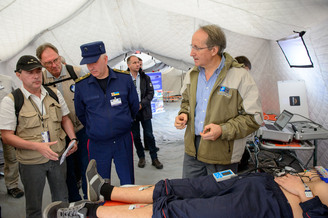NATO tests telemedicine system in Ukraine
NATO is developing a multinational telemedicine system to improve access to health services and increase survival rates in emergency situations, including in remote areas. The technology was successfully live tested during a field exercise in Lviv, Ukraine in September 2015, attended by NATO Secretary General Jens Stoltenberg and the President of Ukraine, Petro Poroshenko.

Saving lives

Once developed, the multinational telemedicine system will have a dual-use for both civilian and military application, including crisis situations. Portable medical kits allow first responders to connect to the system to receive advice from medical specialists in case of an emergency, even in remote areas. Through the use of modern communications technologies, an international network of medical specialists will be able to assess the patient, determine the diagnosis and provide real-time recommendations. Based on cutting-edge technology, the new platform represents a major step forward in live, real-time incident response health service delivery.
“The telemedicine project has high-level political backing and involves an incredible pool of scientists and experts. It aims to save lives in emergency situations as well as in military operations,” said Ambassador Sorin Ducaru, Assistant Secretary General of the NATO Emerging Security Challenges Division. “Today, NATO prioritises ensuring greater security for fewer resources through increased cooperation and efficiency. This SPS project is an excellent example of this,” he added.
Telemedicine supports the teams on the ground in remote areas with expertise that is not present at the scene of the disaster. This will allow to quickly get the right aid and care to those who need it most, having the potential to save many lives on the battlefield as well as in disasters with civilian casualties.
Against the background of the current conflict in Ukraine, this multinational telemedicine system has the potential to increase survival rates in remote areas, including for wounded Ukrainian soldiers.
The creation of a set of guidelines is envisioned based on existing standards, so that in the future, other countries may be able to connect their national telemedicine system into the wider, multinational capability.
Involving NATO partners
Supported by the SPS Programme, this cooperation between Allied countries Romania, the United States, as well as NATO partners Finland, the Republic of Moldova and Ukraine will also provide advanced equipment and training for users of the system.
The partner countries involved contribute experience and knowledge to this project. Finland, for instance, has an advanced national telemedicine capability in place which brings related subject matter expertise. Moldova and Ukraine are providing highly qualified medical and communication technology personnel with a particular focus on emergency situations.
